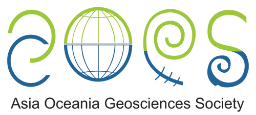
Meetings related to VarSITI:
13th Annual Meeting Asia Oceania Geosciences Society
Asia Oceania Geosciences Society (AOGS) was established in 2003 to promote geosciences and its application for the benefit of humanity, specifically in Asia and Oceania and with an overarching approach to global issues. Read more about AOGS
13th Annual Meeting Asia Oceania Geosciences Society
July 31 - August 5, 2016, Beijing, China
web-address: http://www.asiaoceania.org/aogs2016/

Address: 1 Commonwealth Lane, #06-23 ONE COMMONWEALTH, Singapore 149544
On all matters relating to orders, processing and onsite arrangements geomeet[at]asiaoceania.org
On all matters relating to session proposals, abstracts, registration and fee payment info[at]asiaoceania.org
Abstract Deadline: 19 February 2016 extended to March 04, 2016
The organizers encourage submission of manuscripts for the section of interest and particularly to section below: List of sessions for which VarSITI participants are invited
Received on Feb 09, 2016
Shunrong Zhang
ST17, Ionosphere And Thermosphere Dynamics And Coupling
Convener: Shunrong Zhang (Massachusetts Institute of Technology, USA),
Co-Conveners: Liubo Liu (Institute of Geology and Geophysics, Chinese Academy of Sciences), Yongliang Zhang (Johns Hopkins University, USA), Jiuhou Lei (University of Science and Technology of China, China), Huixin Liu (Kyushu University, Japan)
Mass, momentum, and energy exchanges between the ionosphere and thermosphere (IT) are some of the key subject areas in aeronomy. These processes are know to be fundamental, and may become intensified due to enhancements of direct and indirect impacts from the sun emitting UV radiation and energetic particles. As a result, the ionosphere and thermosphere exhibit strong variability on various spatial and temporal scales, varying with latitudes and disturbance development stages. Characteristic IT variations, in the form of disturbance winds and composition in neutral particles, ionospheric dynamo fields as well as polarization fields, traveling atmospheric/ionospheric disturbances, etc, have long been the very active research focuses in our community. We are organizing this session for the purpose of promoting analysis, observation, and modeling leading to the enhanced understanding of ionospheric and thermospheric dynamics and coupling. Topic areas of particular interest to this session include, but not limited to, 1) correlation between EIA and Equatorial Thermospheric Anomaly (ETA); 2) storm-time ionosphere and thermosphere variations; 3) traveling ionospheric and atmospheric disturbances (TIDs/TADs) in general and, in particular, during magnetic storms; 4) IT perturbations originated from the below; and 5) magnetospheric inputs to the IT system and the IT feedback.
Received on Dec 15, 2015
Yuming Wang
member of ISEST SOC
ST24, Formation, Evolution and Instability of Magnetic Flux Ropes
Conveners: Yuming Wang (China), Hiroshi Hasegawa (Japan), Bernhard Kliem (Germany), Qiang Hu (USA)
Magnetic flux ropes are one of the fundamental elements in solar, space and plasma physics, and could exist crossing multiple scales. They are believed to be the main carrier of magnetic free energy for various large-scale eruptive phenomena, e.g., solar/astrophysical jets, coronal mass ejections and substorms, and they also could form during reconnections, appearing as magnetic islands in the microscopic scale. It has been for decades to search signatures of magnetic flux ropes from solar atmosphere, interplanetary space, magnetosphere to our universe. They also have been studied in laboratory plasma devices. However, the formation, evolution and instability of magnetic flux ropes are still not clear enough. This session solicits contributions focusing on the fundamental physics of the magnetic flux ropes from either observations/laboratory experiments or theoretical analysis.
Received on Jan 10, 2016
Sushil Kumar
Convener of ST25
ST25, Space Weather Impact on the Ionosphere and Dependent Technologies
Conveners: Frederick Menk (The University of Newcastle, Australia), Sushil Kumar (The University of the South Pacific, Fiji)
Co-Conveners: Duggirala Pallamraju (Physical Research Laboratory, India), Brett Carter (RMIT University, Australia)
Our economic, social and environmental security depend critically and increasingly on remote sensing, navigation and communication services from space. Space weather Ц disturbances to the near-Earth space environment resulting from solar activity Ц poses significant threats to modern space-based and terrestrial technologies. Consequences include compromised satellite operations; disruption to communication links and global navigation and timing services (e.g. GPS); impacts on ionospheric services including over-the-horizon radars and low frequency radio astronomy; and the generation of damaging electrical currents in metallic networks such as power grids and pipelines. A growing reliance on meteorological and climatological data from radio occultation satellites increases the vulnerability to space weather effects. While space weather events may be triggered by solar flares and coronal mass ejections, their effects on the ionosphere vary with latitude and local time and are highly variable.
In this session we welcome contributions on experimental observations, empirical and theoretical modelling studies, and forecasting efforts, concerning space weather impacts on the ionosphere and associated services including GPS, remote sensing and radio occultation operations. Papers dealing with monitoring and causes of scintillation, D-region effects associated with severe space weather events, GPS meteorology missions such as COSMIC, and Geomagnetically Induced Currents, are particularly welcome.